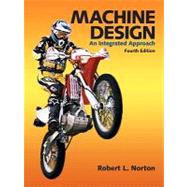For courses in Machine Design.
Machine Design, 4/e, presents the subject matter in an up-to-date and thorough manner with a strong design emphasis. This textbook emphasizes both failure theory and analysis as well as emphasizing the synthesis and design aspects of machine elements. The book points out the commonality of the analytical approaches needed to design a wide variety of elements and emphasizes the use of computer-aided engineering as an approach to the design and analysis of these classes of problems.
An integrated, case-based approach to Machine Design.
Robert Norton's Machine Design is an up-to-date text that helps students develop a fundamental understanding of the underlying theories behind design problems. Rather than taking a "cookbook" approach to the subject that presents a collection of disparate topics, this text offers an integrated approach to machine elements using case studies to illustrate and tie key concepts together.
Introduction to Design; Materials and Processes; Load Determination; Stress, Strain, and Deflection; Static Failure Theories; Fatigue Failure Theories; Surface Failure; Finite Element Analysis; Design Case Studies; Shafts, Keys, and Couplings; Bearings and Lubrication; Spur Gears; Helical, Bevel, and Worm Gears; Spring Design; Screws and Fasteners; Weldments; Clutches and Breaks; Material Properties; Beam Tables; Stress-Concentration Factors For anyone interested in understanding the theory behind machine design.
“The book’s pedagogy is the best and most unique of the available mechanical engineering design texts. In each of the chapters covering a machine design component (Part II sections), there is a detailed discussion on the relevant failure modes (static, surface, and/or fatigue). The material is truly integrated. This integrated approach makes the text very helpful for students currently in the course, undertaking student design projects, and/or professional engineers.” - Ali Gordon, University of Central Florida
“The text provides a wide amount of information for each of the machine design components. For example, in the section on gears, fatigue, yielding, and surface failure are all covered.” - Ali Gordon, University of Central Florida
“Many of the formulations, tables, and figures throughout the book are in close resemblance to what engineers will encounter outside of the classroom.” - Ali Gordon, University of Central Florida








